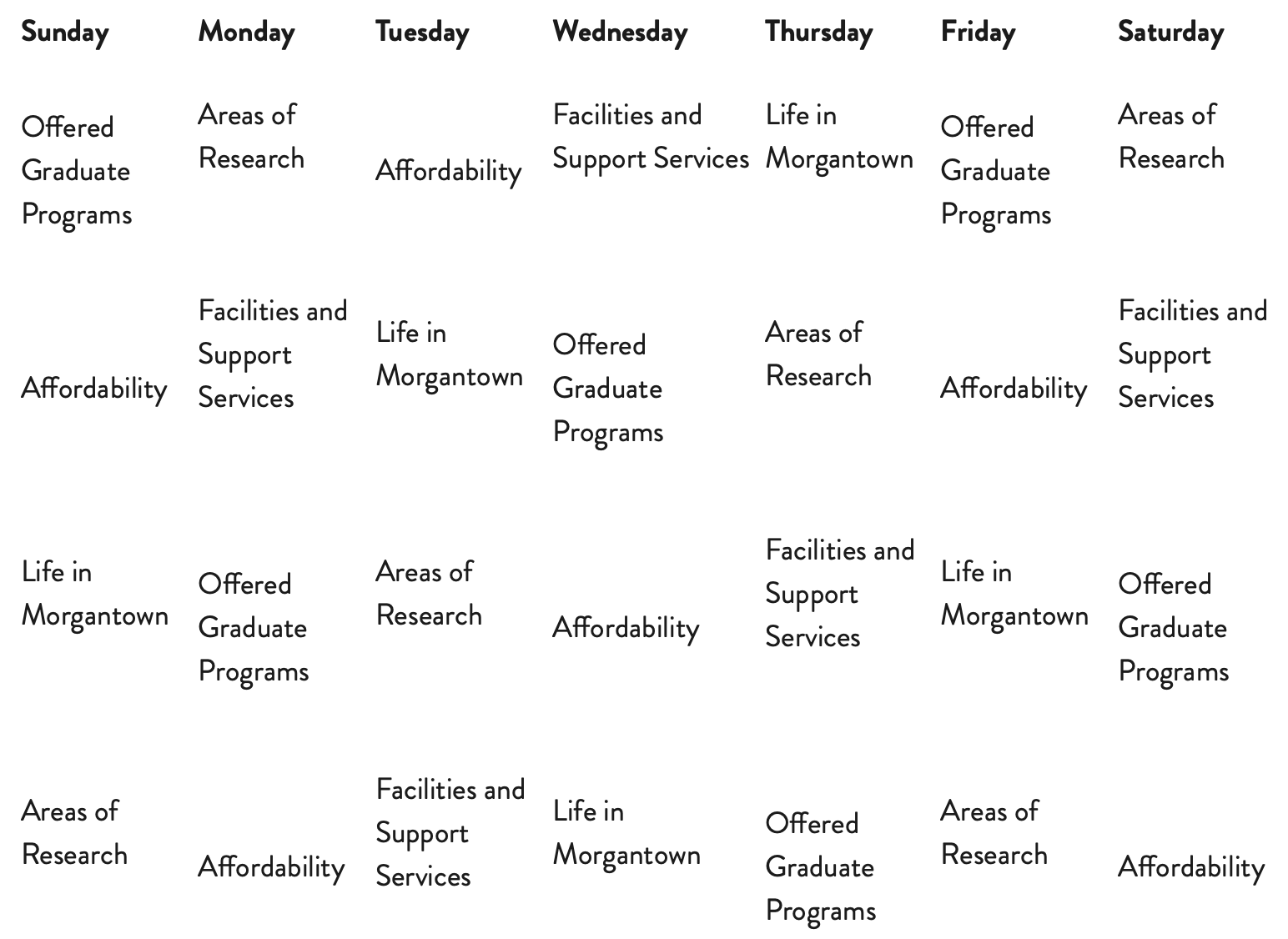As higher education marketers, we know that to stay relevant and engage with our audience we have to publish content regularly on social media. I remember a time when it could easily take me two to four hours in one sitting to plan, create or curate, and schedule content for organic social media.
If you operate on a team that is limited in size, time is of the essence. Likely, all team members are balancing varying responsibilities so devoting even a quarter of your day to social media planning is not the best use of your time. Instead, I advocate for a systematic approach that eliminates the uncertainties around what content to share, how that content should be displayed, and when that content should be published. Similar to the steps you take to get ready for work in the morning, I’ve developed a routine to organic social media that ultimately will give you time back in your day.
Content Topics
We must approach content from the lens of the potential student. What information is going to help the potential student make the decision to apply (and hopefully attend) your institution? The list of considerations for potential students could be quite long. We have to make that list of considerations manageable. At West Virginia University Graduate Admissions and Recruitment (OGAR), we have determined five distinct topics for potential graduate student considerations:
- Offered graduate programs
- Areas of research
- Affordability
- Facilities and support services
- Life in Morgantown
The content we publish on social media must relate to one of the above content topics. Setting boundaries for the topics of content shared on social media allows us to focus on how to display the content (ex: blog, graphic, photos, video, etc.), instead of focusing on what to publish. Social media is becoming an increasingly visual platform. Developing and testing creative and unique ways to show your audience the content will reward you with knowing what types of content work and don’t work with your audience, which in turn will influence future content and grow reach and engagement.
It is important to note that it is not the responsibility of OGAR to develop content to satisfy the above content topics. In the spirit of campus collaboration, OGAR relies on departments across campus to provide the content shared on social media, informally.
Content Development/Curation
The essence of this approach is time saving. To make the most of our time we must rely on the individual departments that provide the product or service to the student. It overwhelms me to think that one (likely small) department should develop, produce, and share content revolving around the above content topics. If that were the case I guarantee difficulty making sure equal content for each topic is created and ensuring the end result is high quality. Instead, we must think of each department as the expert.
Let each department own the product or service they provide and simply share the content they are publishing. My rule of thumb is if the department shared it and the account is public, the content is eligible to be shared with the appropriate credit given. At OGAR we outlined various digital resources, related to our five content topics, to peruse for content to share on social media.
- Offered graduate programs
- Each college/school news and events web page and social media accounts
- Graduate Admissions Website – database of offered graduate programs
- The Summit Ahead blog (a graduate admissions blog managed by the OGAR and one of our vendors)
- Areas of research
- Each college/school news and events, or faculty web pages and social media accounts
- The Summit Ahead blog
- WVU ENews (an internal employee eNewsletter)
- WVU Research Repository website
- WVUToday website and social media accounts (University-level news)
- Affordability
- Each college/school program specific web page and social media accounts
- Office of Graduate Education and Life website and social media accounts (the current graduate student support unit supporting the policy for Fellowships and Graduate Assistantships)
- Office of Student Financial Support and Services website and social media (Financial Aid)
- The Summit Ahead blog
- Facilities and support services
- Campus Recreation Center
- Career Services Center
- Libraries
- Office of Graduate Education and Life
- Student Family Resources
- Student Organizations
- Teaching and Learning Commons
- WellWVU
- Life in Morgantown
- Morgantown Chamber of Commerce
- Morgantown Convention and Visitors Bureau
- Off-Campus Housing
- University Apartments
- #WVUGraduateSchool (user-generated content, any posts from current students and alumni that include the hashtag)
How is OGAR using the time we used to spend haphazardly planning and searching for content to share? Relationship building with colleges/schools and departments to uncover outcomes and stories related to graduate education at WVU. Recently the University hosted its inaugural Research Week. I reached out to all the departments hosting events where graduate faculty and student researchers would be present. Since faculty and students were already planning to attend, I leveraged the events to conduct video interviews.
The intent of the interviews was to afford the researchers the opportunity to discuss their research area and the impact it has on the larger community (which will resonate with potential students interested in participating in research at WVU). The decision to produce video content is to begin introducing new types of content to our social media strategy, A/B testing which content type produces the most reach and engagement with our audience.
Without having our content topics and curation resources defined, we wouldn’t have known where to find Research Week content being produced by each department to share, and we wouldn’t have had the time to meet faculty and students and share their stories.
Routine Schedule
Have you ever tried to put together furniture from Ikea? You’ve laid out all the pieces, you know what the end product is supposed to look like, but how do you make that happen? You can assume pieces A and B fasten together, or you can read the directions. At this point you know what topics to share with your audience, and you’ve either created or curated amazing content (the pieces). You know you want to share the content on social media (the end product). You can haphazardly publish a “piece”, or you can “follow the directions”.
I am advocate for “following directions” or more accurately, developing a routine to publishing content. I have wasted too much time staring at a social media scheduling tool deciding what to publish, staring at the pieces willing it to become the end result. Developing a routine to publishing your content eliminates the guessing game and expedites the scheduling process. Developing a routine is simple, assign one content topic per day during a given week then repeat.
An important thing to note is that the content topic is not limited to only being posted on its initial day. The initial schedule is meant to drive a cycle. You’ll see in the example below that the same topic is published every five days, per the developed routine.


What’s Next?
Data! Repeat your publishing routine for a few weeks and analyze the results. Collect the data that relates most to your goal (data paralysis is a killer to what would otherwise garner productive insights), e.g. if you are looking to grow your audience, look specifically at reach. Start asking questions to guide content development and A/B tests:
- Which topic performed the best overall (garnered the most reach, in staying with the above example)?
- What were the top three posts, with the most reach, in that topic?
- What types of content where published (blog, link, photo, video)?
- What time and resources do we have to develop an additional content type of the top three posts?
Once you create or curate, and publish the new content type, you guessed it, collect and compare the data!
Ideally, the systematic approach to organic social media will you have free up the time previously spent on planning and scheduling, allowing you to focus on initiatives that will truly move the needle!
Click here to read this article on the Enrollify website.





